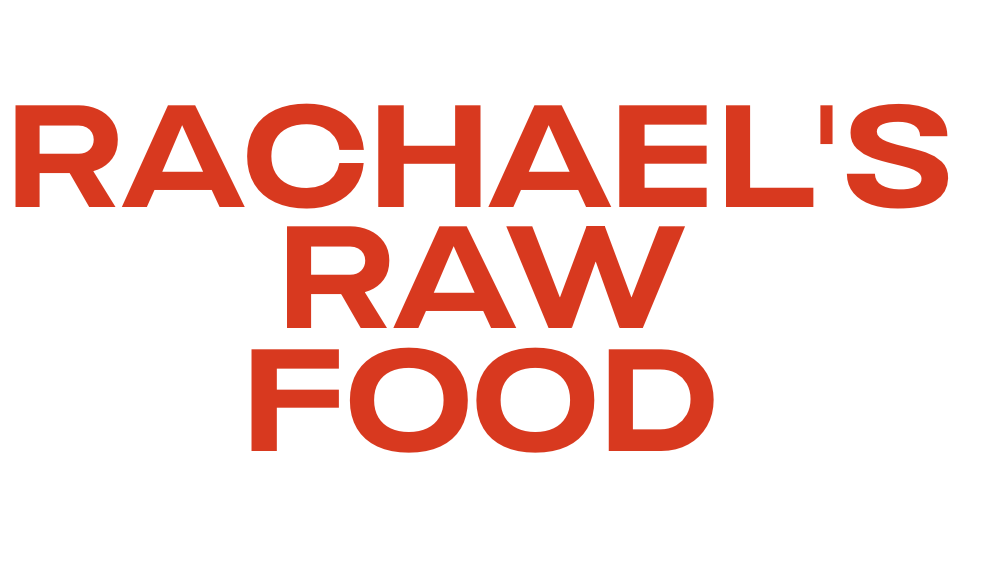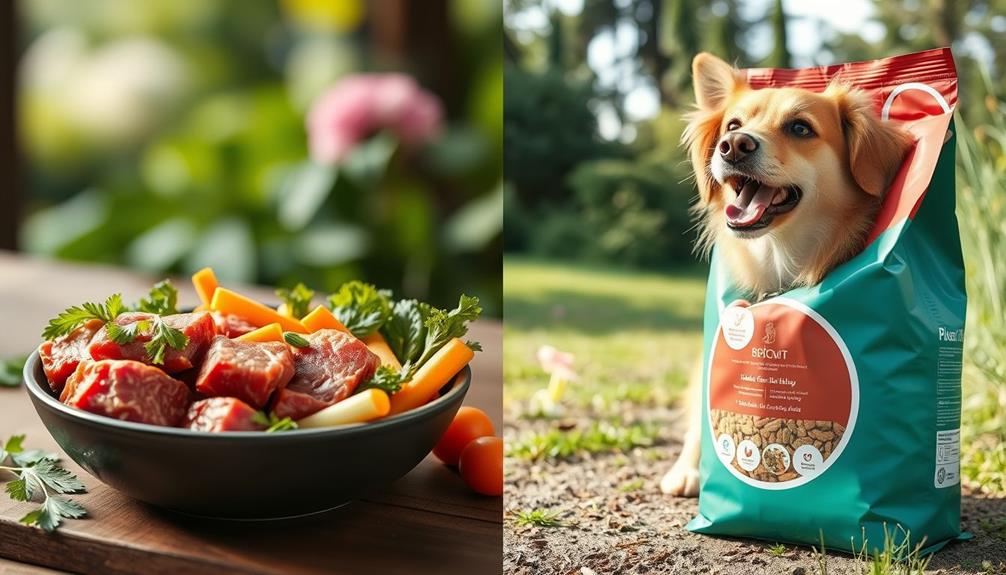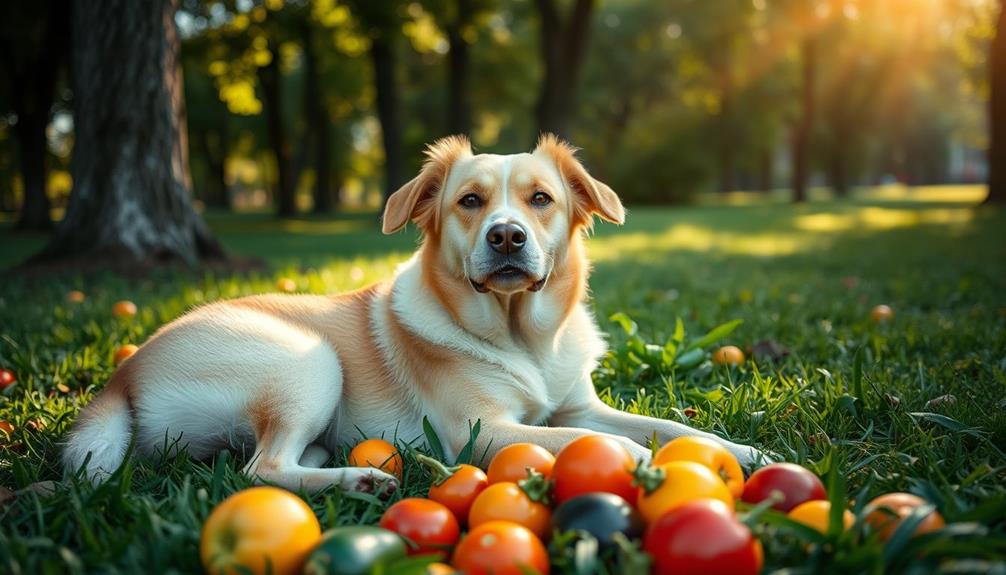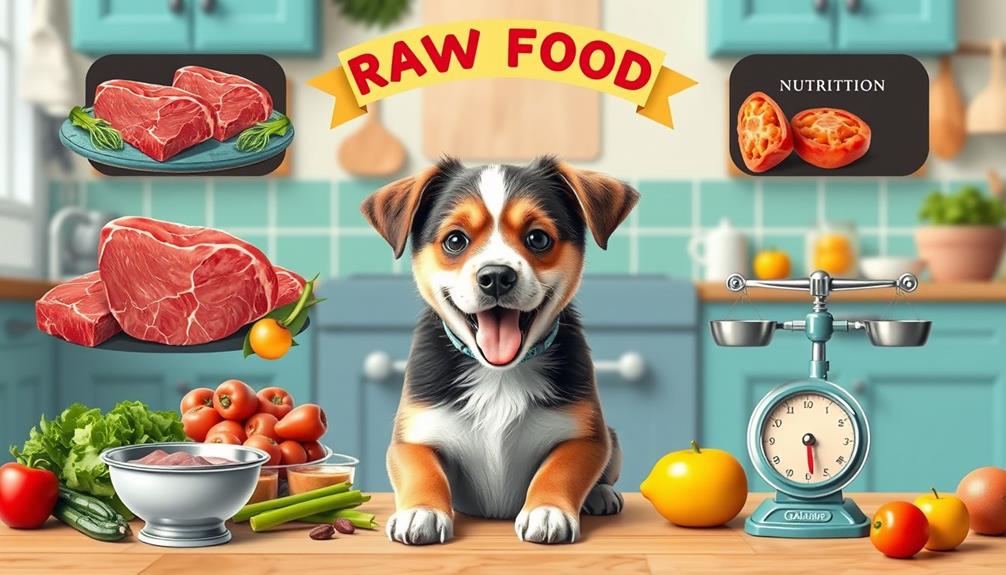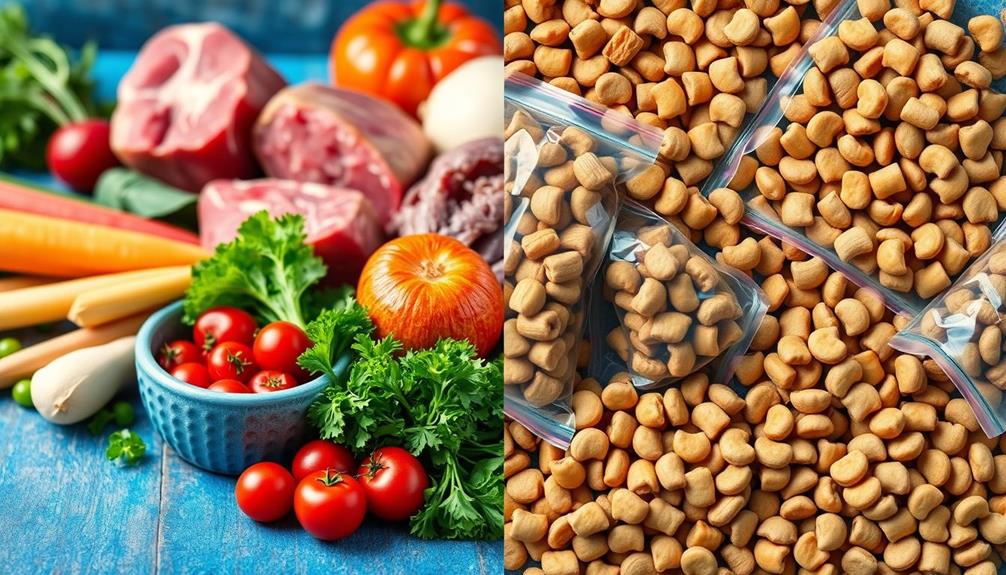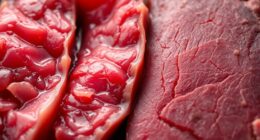Feeding your dog raw food has its pros and cons. On the positive side, you might notice improved coat health, increased energy, and better dental health from chewing bones. However, you'll need to be cautious of nutritional deficiencies and health risks, like bacterial contamination. Shifting requires careful preparation and hygiene practices. It's crucial to consult a veterinarian to guarantee your dog's diet is balanced and safe. While some owners swear by raw feeding, it's not right for every dog. There's a lot more to discover about managing a raw diet effectively, so keep exploring the options. Before making the switch to a raw food diet for dogs, it’s important to do thorough research and consider the potential risks and benefits. It’s also essential to gradually introduce raw food into your dog’s diet and monitor their health closely. Additionally, keep in mind that not all raw food options are created equal, so it’s crucial to choose high-quality, safe ingredients for your dog’s meals. Consulting with a veterinary nutritionist can also provide valuable guidance and ensure that your dog’s nutritional needs are being met.
Key Takeaways
- Raw dog food may improve coat health and energy levels due to higher fat content and nutrient absorption.
- Nutritional imbalances and bacterial risks, such as Salmonella, are significant concerns with raw diets.
- Regular veterinary consultation is essential to ensure balanced nutrition and monitor health impacts.
- Raw diets can lead to firmer stools and better digestive health but may not suit all dogs.
- Safe food handling practices are crucial to minimize contamination risks when feeding raw food.
Overview of Raw Dog Food
When it comes to feeding your dog, the idea of a raw food diet sparks both interest and debate among pet owners. Raw dog food typically consists of uncooked meat, bones, fruits, and vegetables, aiming to mimic the ancestral diet of canines before domestication.
The BARF diet, introduced by Ian Billinghurst in 1993, has gained traction among those looking for a more natural feeding option. Some advocates claim that raw diets can enhance your dog's overall health, similar to how proper hamster care can lead to a healthier pet ultimate hamster care guide.
While some advocates tout benefits like shinier coats and improved energy levels, there are significant concerns to take into account. Mainstream veterinarians and the FDA warn about the potential for nutritional deficiencies and the risk of bacteria in raw food.
It's essential to recognize that a balanced diet for your dog should include proteins, fats, carbohydrates, vitamins, and minerals.
Before making any dietary changes, consulting with a veterinarian or a certified nutritionist is important. They can help you understand how to create a balanced raw diet that meets your dog's needs while mitigating risks.
Ultimately, while raw dog food can be appealing, it's critical to approach this feeding method with caution and informed guidance.
Potential Benefits of Raw Diet
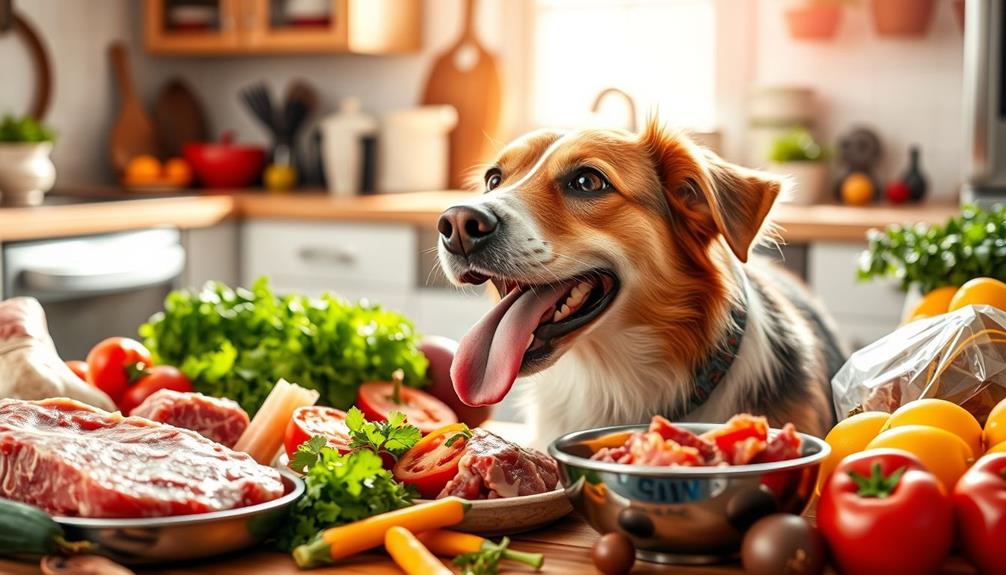
Switching your dog to a raw diet might lead to noticeable improvements in coat health and digestive function.
Many owners report shinier fur and healthier skin thanks to the natural fats in raw food. Additionally, the increased nutrient absorption may contribute to an overall boost in energy, similar to the benefits seen with cranberry juice consumption.
You may also notice firmer stools, suggesting that your dog is absorbing nutrients more effectively.
Improved Coat Health
Many dog owners often notice remarkable improvements in their pets' coat health after altering to a raw food diet. This improvement is often attributed to the higher fat content and essential fatty acids found in raw meat. These nutrients can make your dog's coat shinier and healthier overall, similar to the way herbal teas like chamomile and ginger may alleviate discomfort in humans.
Since raw food diets typically lack fillers and artificial additives, your dog receives more natural nutrients from whole food sources, which can also enhance coat quality.
Additionally, many owners report that their dogs experience fewer skin allergies and irritations after changing to a raw diet. This reduction can lead to improved coat conditions, making fur softer and less prone to dryness and shedding.
The inclusion of raw fruits and vegetables in these diets provides essential vitamins and antioxidants, further supporting skin health and coat shine.
If you're looking to boost your dog's coat health, consider the potential benefits of a raw food diet. While individual results may vary, many pet owners have seen their dogs thrive with this approach, showcasing the positive impact of natural nutrition on fur and skin health.
Enhanced Digestive Function
A raw food diet not only benefits your dog's coat health but can also greatly enhance their digestive function. Advocates of raw diets point out that the increased protein content and natural enzymes found in raw foods help improve nutrient absorption.
For instance, feeding your dog healthy snacks made from natural ingredients can complement a raw food regimen by providing additional nutritional support. By feeding a raw diet, you may notice your dog's stools become smaller and firmer, which indicates better nutrient utilization and improved digestive health.
Raw diets often include fibrous fruits and vegetables, contributing to healthier gut flora and promoting regular bowel movements. Many dog owners report a decrease in gastrointestinal issues, such as bloating and gas, after switching to a raw food diet.
This improvement could be linked to the absence of fillers and artificial additives common in commercial dog foods, which reduces the risk of food sensitivities.
In essence, a raw food diet can lead to enhanced digestive function, allowing your dog to thrive on a more natural diet. If you're considering this approach, it's crucial to ascertain that the diet is balanced and appropriate for your dog's specific needs.
With the right raw diet, you could see significant improvements in your dog's overall digestive health.
Health Risks and Concerns
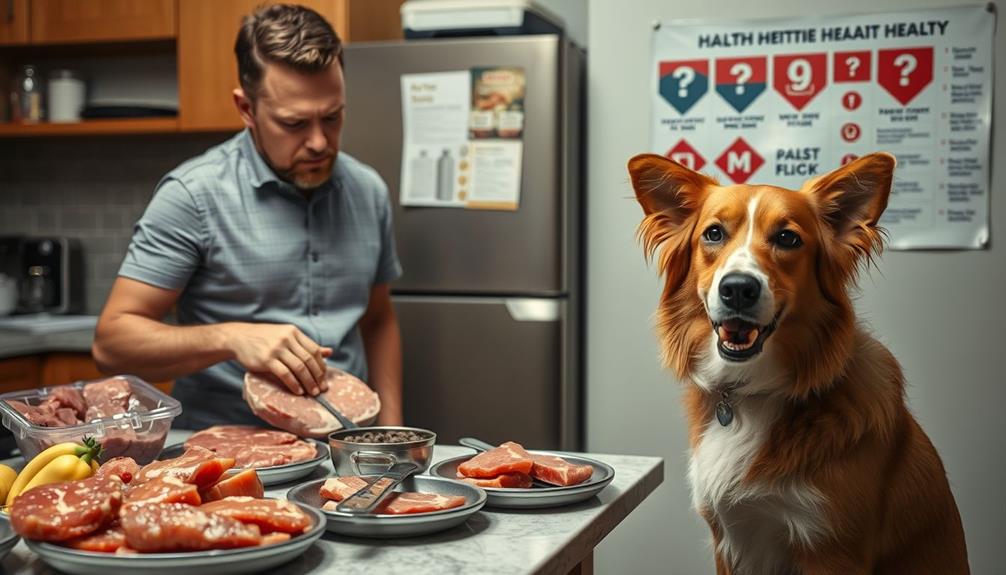
Feeding your dog a raw food diet can pose significant health risks that you shouldn't ignore. One major concern is the presence of harmful bacteria like Salmonella and E. coli, which can lead to serious health problems for both your pet and your family. Additionally, if the raw diet isn't balanced properly, nutritional deficiencies may develop over time, affecting your dog's overall health.
Another risk involves whole bones, which can cause choking, broken teeth, or even internal injuries. The FDA has highlighted the increased bacterial contamination associated with raw pet food, raising the chance of foodborne illnesses.
For dogs with existing health conditions, such as kidney failure or pancreatitis, a raw diet could exacerbate their symptoms, making it essential to consult a veterinarian before making any changes.
Here's a quick summary of the health risks associated with raw food diets:
| Health Concerns | Description | Example |
|---|---|---|
| Harmful Bacteria | Risk of Salmonella and E. coli | Foodborne illness |
| Nutritional Deficiencies | Incomplete diet leading to health problems | Weak immune system |
| Choking Hazards | Whole bones causing choking or injuries | Broken teeth |
| Bacterial Contamination | Increased risk of severe contamination | Illness in pets |
| Exacerbation of Conditions | Worsening symptoms in pre-existing health issues | Kidney failure |
Key Guidelines for Raw Feeding
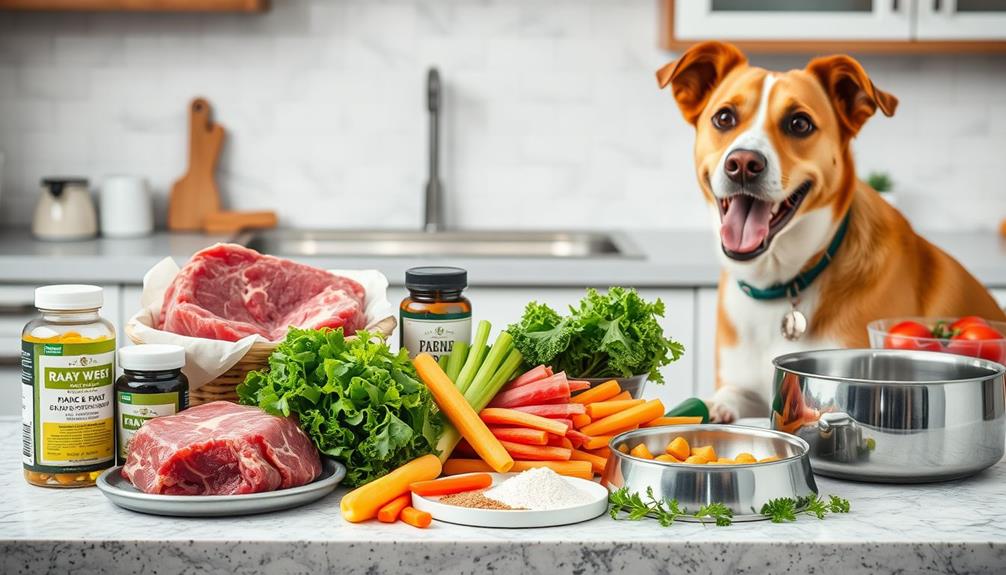
When considering a raw food diet for your dog, it's vital to guarantee nutritional balance by including all necessary components. Incorporating a variety of proteins, vegetables, and supplements can help maintain this balance.
You should also prioritize safe food handling to reduce any risk of contamination, similar to how essential oils like eucalyptus oil can assist in maintaining health through proper care.
Nutritional Balance Requirements
Creating a well-balanced raw diet for your dog involves more than just tossing in some meat. To meet your dog's nutritional needs, focus on a variety of components. Following the AAFCO nutrient profiles is vital for guaranteeing adequate vitamins and minerals.
Additionally, it's important to take into account the long-term health implications of dietary choices, as maintaining a balanced diet can prevent future health issues. For more insights on caregiver support related to nutritional needs, check out the resources available.
Here are three key elements to include in your raw diet:
- Protein Sources: Aim for about 70-80% muscle meat. This provides the essential amino acids your dog needs for energy and muscle maintenance.
- Bones: Incorporate 10-15% bones, preferably raw and meaty. They offer calcium and phosphorus, essential for overall health and dental hygiene.
- Organ Meat: Include 10-15% organ meat, such as liver or kidney. This is rich in vitamins and minerals that support various bodily functions.
Pay special attention to puppies, as they require specific calcium and phosphorus ratios to prevent growth issues.
Regularly monitor your dog's health and adjust their balanced raw diet as needed. With careful planning and consultation with a veterinarian or nutritionist, you can guarantee your dog thrives on a raw diet that meets their evolving nutritional requirements.
Safe Food Handling
Safe food handling is fundamental for anyone feeding their dog a raw diet. To keep your pet healthy and prevent harmful bacteria, always wash your hands thoroughly with soap and water before and after handling raw pet food.
Use separate cutting boards and utensils specifically for raw dog food to avoid cross-contamination with food meant for human consumption. Additionally, understanding the safety of a raw food diet is essential, as proper food handling can notably reduce health risks associated with bacterial contamination.
Store your raw pet food in the refrigerator or freezer to minimize spoilage. Remember, it's essential to consume or discard it within a safe timeframe—generally no longer than 2 hours at room temperature.
Regularly clean and disinfect all surfaces, bowls, and feeding areas that come into contact with raw food. This practice eliminates potential bacterial contamination.
If you have young children, elderly family members, or anyone who's immunocompromised at home, exercise extra caution. Keep raw pet food out of reach and maintain strict hygiene practices to guarantee everyone's safety.
Whether you're using commercial raw products or preparing your own, these steps are important for safe food handling and the health of both your pet and your household.
Veterinary Consultation Importance
Consulting a veterinarian before starting a raw food diet is essential for guaranteeing your dog's nutritional needs are met. A raw diet can be beneficial, but it requires careful planning and understanding.
For example, understanding the importance of selecting the right cold medication can parallel the need for a balanced approach in dog nutrition.
Here are three key reasons to prioritize veterinary consultation:
- Balanced Diet Guidance: Veterinarians can help you achieve a balanced raw diet that aligns with AAFCO nutrient profiles, reducing the risk of nutritional deficiencies. They'll evaluate your dog's specific needs based on age, weight, and health conditions.
- Monitoring Health Impacts: Regular check-ups allow your vet to monitor any health impacts associated with the raw diet. This proactive approach helps in early detection of potential issues before they become serious.
- Tailored Advice: Discussing your raw food practices with veterinarians fosters transparency and trust. It guarantees you receive informed advice tailored to your pet's health, especially for puppies and senior dogs who may be more vulnerable to complications.
Nutritional Balance in Raw Diets
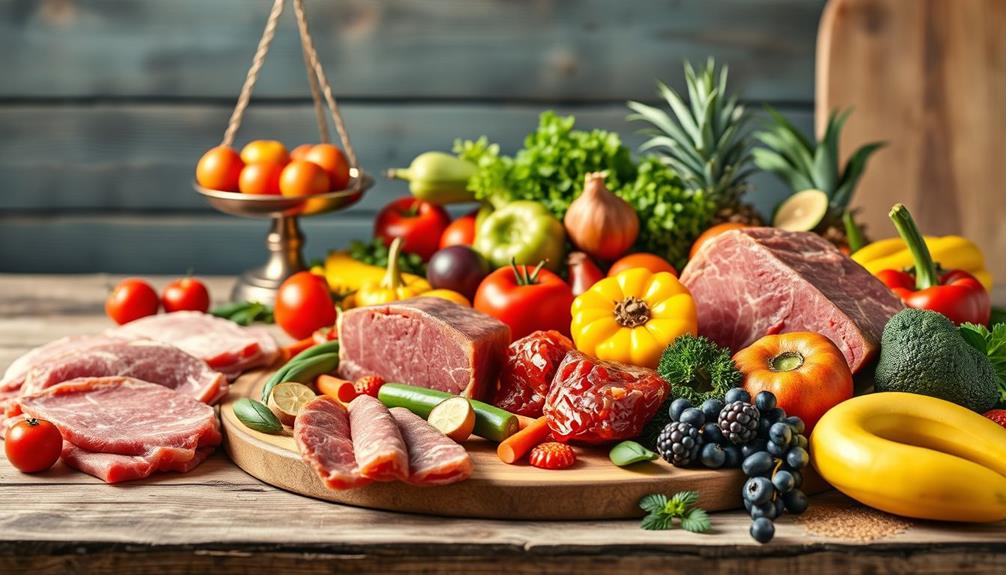
Nutritional balance in raw diets is vital for your dog's health and well-being. Achieving this balance can be challenging, as it requires careful consideration of proteins, fats, carbohydrates, vitamins, and minerals. Without attention to detail, your dog could face nutritional deficiencies that may lead to serious health issues over time.
For example, failing to balance essential nutrients like calcium and phosphorus can have dire consequences. Budgeting for pet care is important to guarantee you can afford high-quality ingredients for your dog's diet.
Many homemade raw diets don't provide adequate vitamins and minerals, which underscores the importance of seeking nutritional consultation when preparing these meals. While limited ingredient raw diets may help manage food allergies, they still require precise formulation to guarantee complete nutrition.
You might notice healthier body conditions in pets on raw diets, but it's important to monitor for nutritional imbalances that can arise from improper dietary practices.
To guarantee your dog thrives on a raw diet, always prioritize a balanced diet that meets the AAFCO nutrient profiles. By doing so, you can help your furry friend enjoy the benefits of raw feeding without the risk of nutritional pitfalls.
Veterinary Perspectives on Raw Food
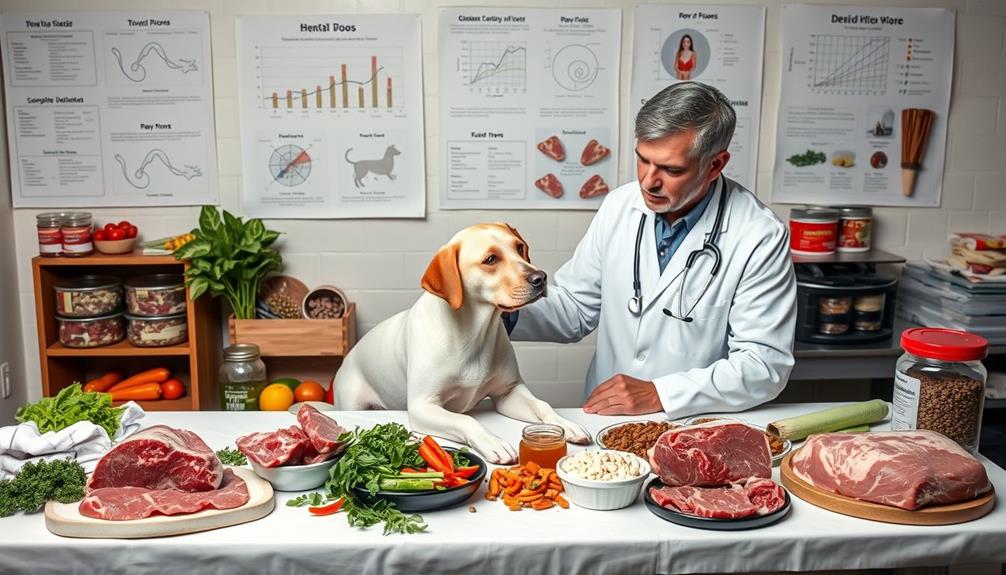
Many veterinarians stress the importance of professional guidance before switching your dog to a raw food diet. Not all dogs are suitable candidates, especially if they've pre-existing health issues.
Additionally, just as with human nutrition, key domains of development can impact how a dog may respond to dietary changes. Here are three key points to take into account:
- Bacterial Contamination: Many veterinary associations express concerns over risks like Salmonella and E. coli associated with raw diets. These bacteria can pose serious health threats not only to your dog but also to your family.
- Balanced Nutrient Profile: It's vital to guarantee a well-balanced nutrient profile when preparing homemade raw diets. Deficiencies can lead to severe health problems over time, affecting your dog's overall well-being.
- Health Impacts and Monitoring: Regular veterinary check-ups are essential for monitoring the health impacts of a raw diet. Your vet can address any dietary concerns that may arise and help you understand both the potential benefits and risks.
Veterinarians are committed to educating clients about raw diets, addressing misconceptions to guarantee you make informed decisions for your dog's health.
Always consult a professional to navigate this complex dietary choice effectively.
Addressing Common Misconceptions
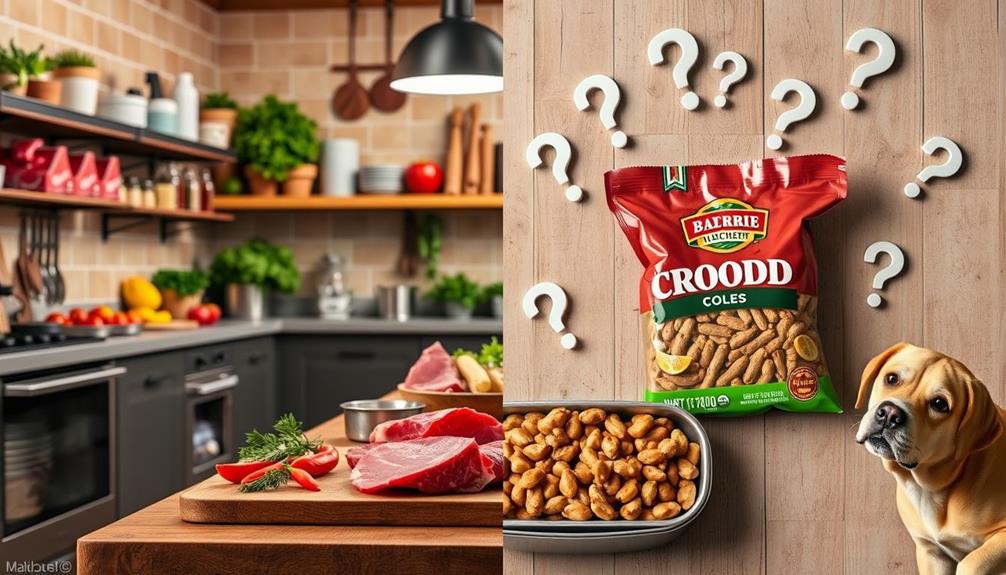
While veterinarians provide valuable insights into the complexities of raw diets, it's important to address the common misconceptions that often surround this feeding approach. Many people believe that raw diets automatically lead to better health for dogs. However, scientific evidence supporting these benefits is limited, and without careful planning, you could face nutritional imbalances.
Another misconception is that raw feeding eliminates the need for supplements. In reality, achieving a balanced nutrient profile can be challenging, and tailored supplementation may be necessary to prevent deficiencies.
Some dog owners also think that raw diets can entirely prevent dental issues. While chewing raw bones can help, it doesn't guarantee protection against periodontal disease, which is still common among dogs.
You might assume that all dogs thrive on raw food, but that's not the case. Certain health conditions, like kidney disease or pancreatitis, may worsen with a raw diet, so considering individual health factors is vital.
Lifestyle Considerations for Owners
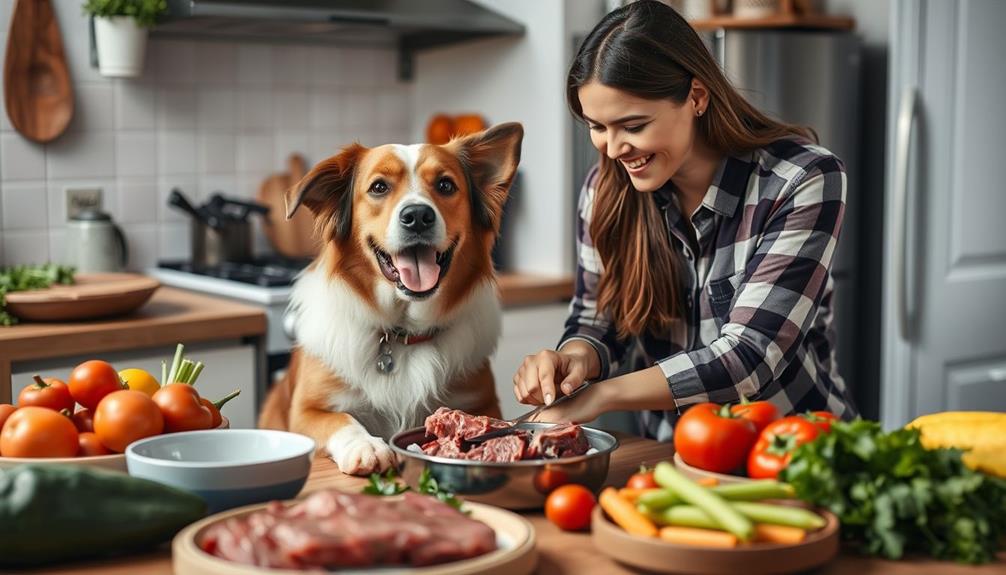
How do you fit the demands of a raw food diet into your busy lifestyle? For many pet owners, the time and effort required for meal preparation can be overwhelming.
While the benefits of a raw food diet are appealing, you need to weigh them against your daily responsibilities. Here are three lifestyle considerations to keep in mind:
- Time Commitment: Preparing raw meals often requires significant time for shopping, prepping, and ensuring food safety. If your schedule is tight, this can be a major hurdle.
- Cost: High-quality raw ingredients can be pricier than the convenience of dry kibble. Consider your budget and whether you're ready for the financial commitment that comes with a raw food diet.
- Nutritional Monitoring: Regularly checking for nutritional deficiencies in raw diets can be challenging, especially if you're not well-versed in pet nutrition. This adds another layer of complexity to your pet care routine.
Ultimately, you need to assess whether the potential benefits of a raw food diet align with your lifestyle and obligations.
Balancing these considerations is vital for any pet owner contemplating this dietary change.
Making the Transition to Raw Food
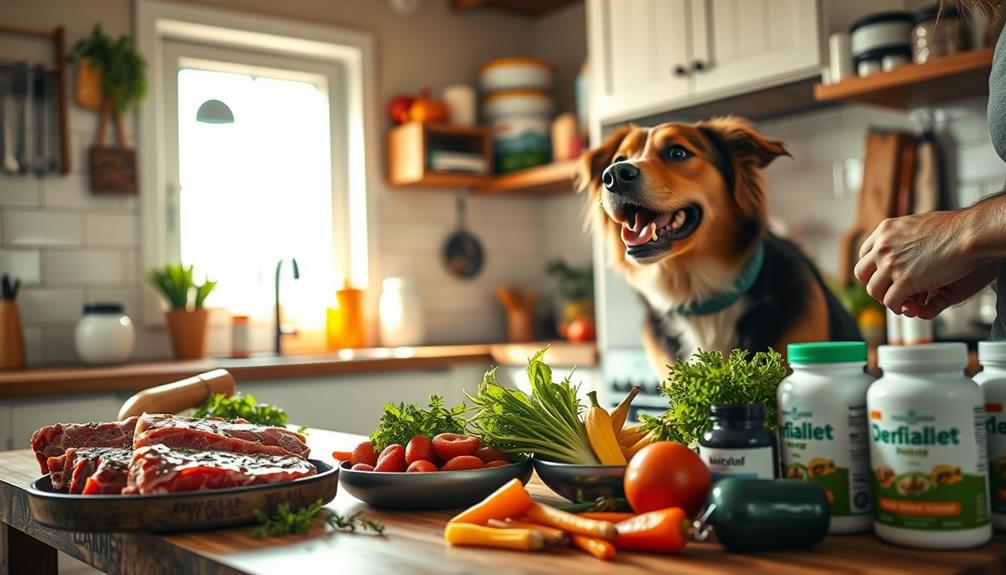
Shifting your dog to a raw food diet can feel intimidating, but taking it step by step makes the process smoother. Start by gradually shifting over 7-10 days, mixing small amounts of raw food with your dog's current kibble. Slowly increase the proportion of raw food while decreasing kibble. This gradual change helps minimize gastrointestinal upset and allows your dog's digestive system to adjust.
During this shift, closely monitor your dog for any signs of discomfort, like vomiting or diarrhea. If issues arise, consult a veterinarian for guidance.
It's essential to guarantee the raw food diet is nutritionally balanced. Include a variety of proteins, fruits, vegetables, and necessary supplements. You might want to consult a certified pet nutritionist to help with this.
Additionally, maintain proper hygiene practices throughout the shift. Safe handling and storage of raw ingredients minimize the risk of bacterial contamination for both your dog and household members.
Frequently Asked Questions
What Are the Negatives of Raw Dog Food?
Raw dog food can lead to bacterial risks, nutritional imbalances, and spoilage issues. You might face preparation challenges, higher costs, and potential choking hazards from whole bones. It's essential to evaluate these negatives before deciding.
Is Raw Food Actually Better for Dogs?
Imagine a wild wolf thriving on a natural diet. You wonder if raw food's benefits for your dog mirror that essentiality. While some swear by it, you should weigh the risks and consult your vet first.
Do Vets Recommend a Raw Diet for Dogs?
Most vets don't recommend a raw diet for dogs due to safety concerns and nutritional balance. It's important to consult a certified pet nutritionist to guarantee your dog's diet meets all necessary health requirements.
Why Do Vets Disagree With Raw Feeding?
"Don't put all your eggs in one basket." Vets disagree with raw feeding mainly due to concerns about bacterial contamination, nutritional imbalances, and risks of choking or injury, especially in households with vulnerable individuals.
Conclusion
In summary, considering a raw food diet for your dog means weighing the benefits against the risks. You'll need to prioritize proper nutrition, maintain hygiene, and stay informed about veterinary advice. If you decide to shift, do so gradually, monitor your dog's health, and guarantee a balanced diet. Ultimately, it's about what works best for you and your furry friend, so trust your instincts, do your research, and make a choice that enhances their well-being.
